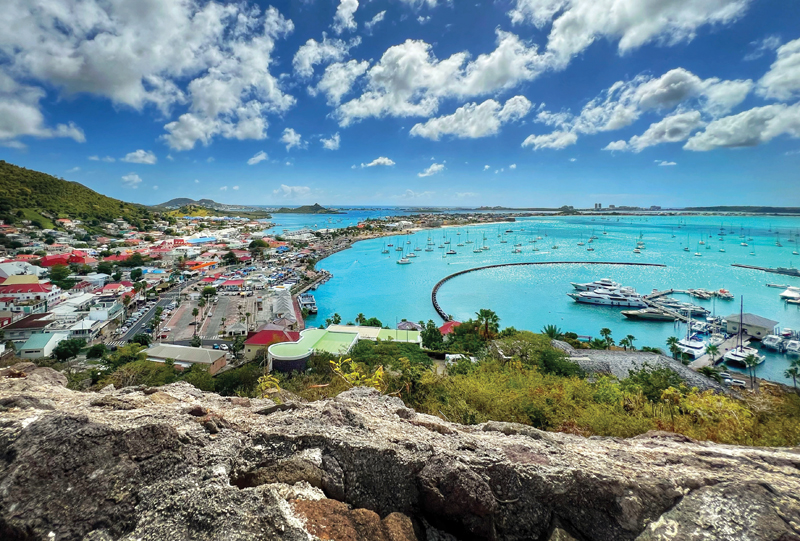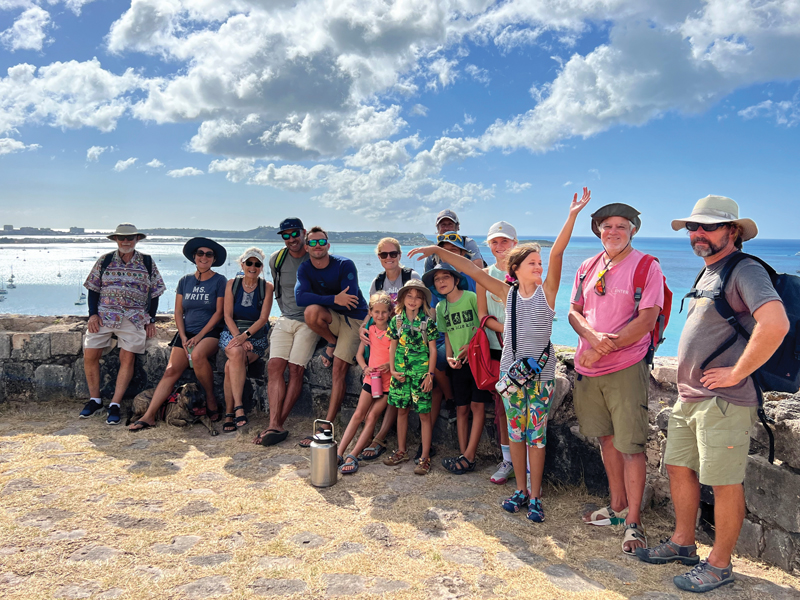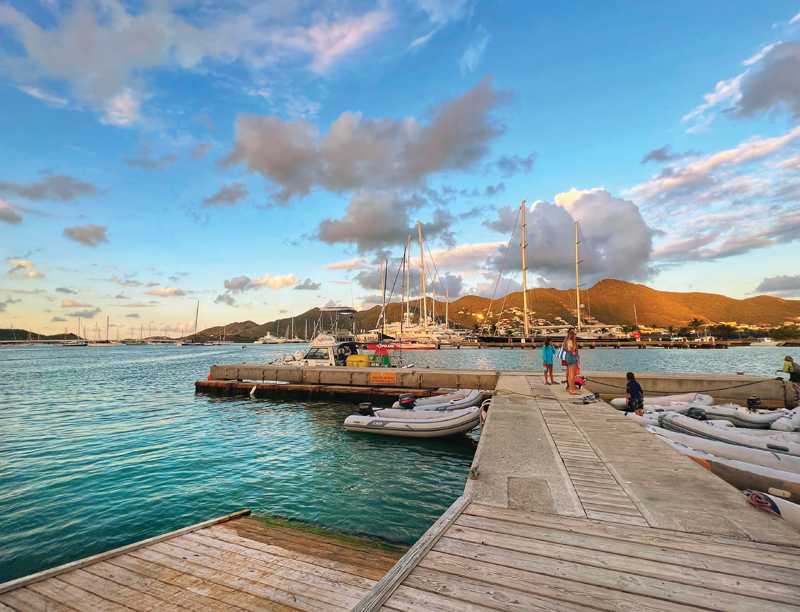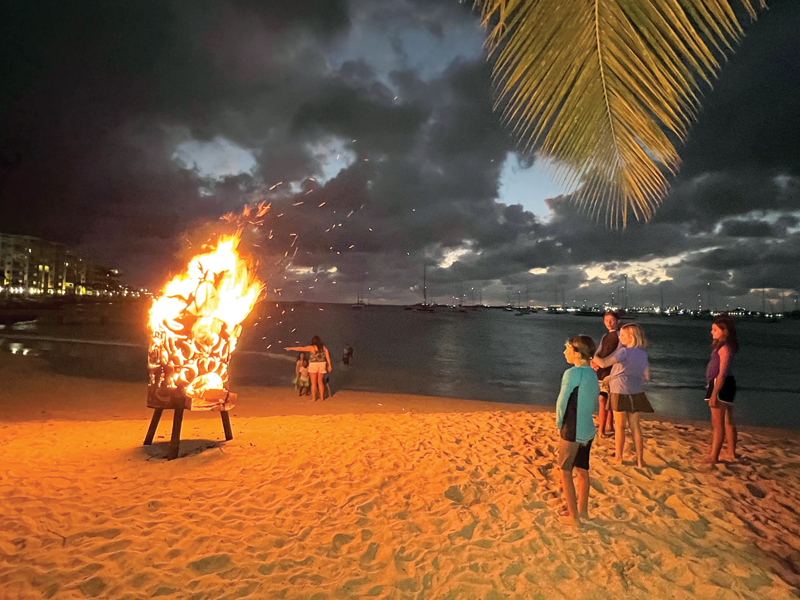One island, two countries, three currencies, and several languages make SXM an interesting cruising destination.
Moving along the Thorny Path through the Caribbean people talk about Saint Martin like it’s Camelot. No matter what you need, it’s there. Good food, boat parts, services, medical care, flights home, and protected anchoring: they have it all.

It can be confusing to sort out what’s what the first time you sail up to the busy shores of SXM. The island measures only 35 square miles and has a population of just 32,000 people, roughly the size of Annapolis. The one island is home to two different countries, Sint Maarten which is Dutch, and Saint Martin, which is French. The shorthand for both places is SXM.
Geographically SXM is where you “turn the corner” when heading south on the Thorny Path. It’s where you finally stop clawing due east against the trades and start pointing south with some hope of sailing your sailboat and making passages more comfortable. When you’re heading north, it’s where the following seas kick in, giving you a sleigh ride back towards the States. The island boasts a completely protected lagoon that straddles both countries, so in blustery winter winds, it’s an ideal spot to sit in still waters and do boat projects.

The two countries, three currencies, and several languages make SXM a true international community. This is the best food island in the Caribbean, with shawarma stands, Indian food, and sushi all sharing the stage with typical Caribbean burger joints. Of course on the French side there are cheap, fresh baguettes, pain au chocolat, and the famous French pastries.
Dealing in three currencies can seem confusing, and it is. The Dutch side officially uses the Netherlands Antillean Guilder (NAF), and the French side uses the euro, but most places will also take US dollars. Often you will see prices in dollars and NAF on the Dutch side. Time to download that currency exchange app. The good news is that you don’t have to carry around three different piles of cash. Most cruisers get euros for the French side (and keep them for the other French islands down the line) and use US dollars or a credit card on the Dutch side. Unlike the rest of the Caribbean where cash is king, most vendors here take plastic and are very flexible about what form of money you hand them.
On the French side expect most people to speak French, and often only French. Saint Martin is considered part of France, not just a territory. When you chat with people, they will often say, “Here in France...” We didn’t meet anyone speaking Dutch in Sint Maarten; business is conducted in English.
People are a mix of African, European, and North American, and immigration from everywhere makes this a truly international island. You might see a Caribbean carnival one night, join an Indian Holi Festival the next day, take in some live music from a top-notch European band, and regattas are a big deal here, too.

Your first decision.
Arriving by boat, you need to decide first which side you want to check into officially. The Dutch side requires a little paperwork and a small fee. If you have pets, they will have requirements too. The French side doesn’t ask if you have pets, and you check in on a computer at the marine chandlery. It’s a one-page form and a few euros. Wherever your boat sits, that’s your official port of entry. But once you’re checked in, you are free to roam by dinghy, foot, or car between the two sides with no border lines to restrict you.

The heart of the cruising community.
Then, there is the lagoon. There are two external bridges that control entry into the lagoon, one in each country. The bridge on the French side is narrow and cannot be transited by a catamaran. There can be a bit of a swell as you come through, and the bridge tender will speak French. The bridge on the Dutch side can be transited by just about any sized boat, including megayachts who squeeze in much to the delight of the drinking patrons of the yacht club. Even if you want to stay on the French side of the lagoon, you can enter through the Dutch side. You drop a hook near the bridge tender on the Dutch side, dinghy over to pay some fees and do some paperwork, and get your boat in line for the next opening. Once inside, you can anchor on the Dutch side, or you can wait for the internal bridge opening that lets you into the French side of the lagoon.
The lagoon is the heart of the cruising community. You can access just about everything you need by dinghy from the protected waters. There are banks, pharmacies, laundry services, garbage dumps, groceries, the best stocked marine chandleries in the Caribbean, sail lofts, bars, beaches, and duty-free mail services.
There’s an active cruisers net on the VHF radio where you can find out about music nights, poker games, swap meets, and information about whatever you need. It’s easy to get sucked into the cruiser scene here and forget about the beautiful things to see and do as a visitor: beaches, hikes, forts, and lovely towns.
It sounds like an overwhelming change of pace from the sleepy backwaters of other Caribbean islands, but it’s still laid back and peaceful. Its popularity among both racing and cruising sailors is well deserved. We pulled in, and before we knew it, six weeks had passed. When you’re craving certain foods while adding to your growing repair list and needing a break, it’s nice to know SXM is on the horizon.
by Cindy Wallach




